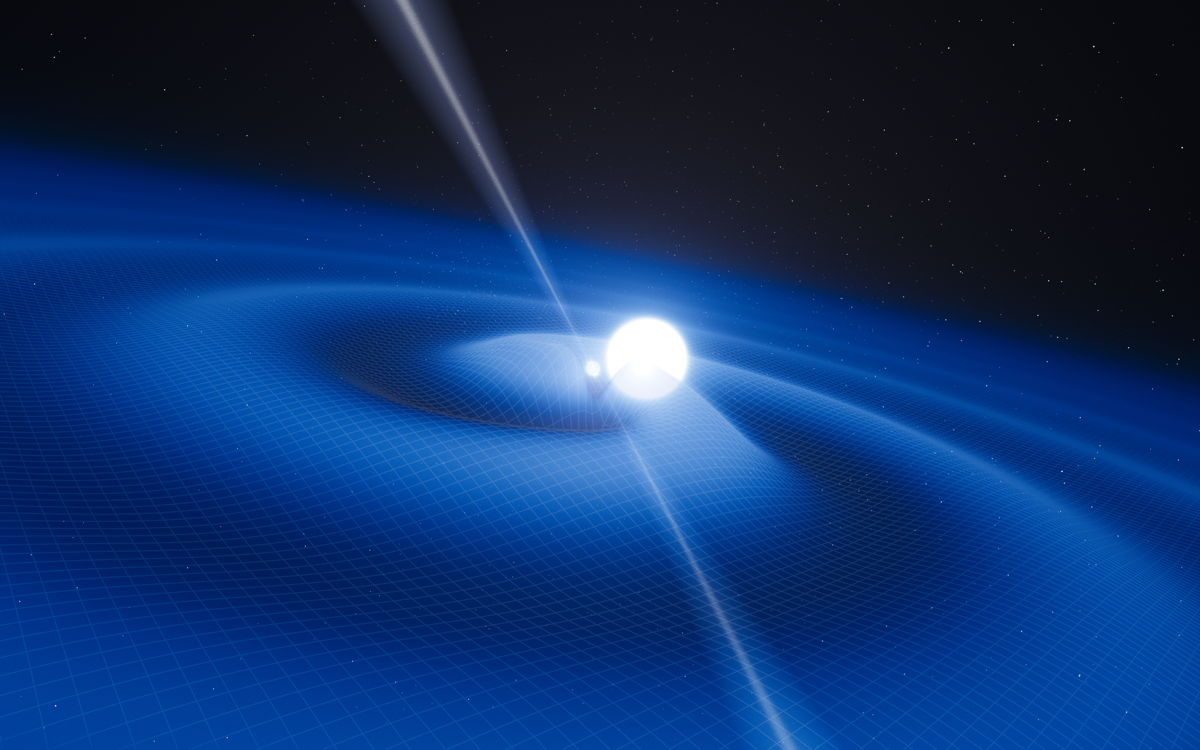Einstein's Gravity Theory Passes Toughest Test Yet

An extreme pair of superdense stars orbiting each other has put Einstein's general theory of relativity to its toughest test yet, and the crazy-haired physicist still comes out on top.
About 7,000 light-years from Earth, an exceptionally massive neutron star that spins around 25 times a second is orbited by a compact, white dwarf star. The gravity of this system is so intense that it offers an unprecedented testing ground for theories of gravity.
Scientists know general relativity, proposed by Albert Einstein in 1915, isn't the complete story. While it does very well describing large, massive systems, it's incompatible with quantum mechanics, which governs the physics of the very small. For something extremely small, yet extremely massive — such as a black hole — the two theories contradict each other, and scientists are left without a physical description. [6 Weird Facts About Gravity]
Rare systems like this binary star pair offer a chance to probe the boundary between the two theories, and search for possible openings toward new physics that could reconcile them.
"We thought this system might be extreme enough to show a breakdown in general relativity, but instead, Einstein's predictions held up quite well," Paulo Freire, an astronomer at the Max Planck Institute for Radio Astronomy in Germany, said in a statement.
Extreme pair

The white dwarf in the pair represents the remains of an aging star that lost its atmosphere and is gradually cooling down. Its companion, the neutron star, is much more massive and is so dense that the protons and electrons in its atoms have collapsed to form neutrons. Created in a supernova explosion that marked the death of a star, the neutron star contains twice the mass of the sun packed into an area just 12 miles (19 kilometers) wide. On the surface of this star, gravity is 300 billion times stronger than on Earth.
Get the Space.com Newsletter
Breaking space news, the latest updates on rocket launches, skywatching events and more!
The neutron star is what's called a pulsar, because it gives off a beam of light that appears to pulse on and off as it rotates past Earth.
"I was observing the system with ESO's [the European Southern Observatory's] Very Large Telescope, looking for changes in the light emitted from the white dwarf caused by its motion around the pulsar," said John Antoniadis, a Ph.D. student at the Max Planck Institute for Radio Astronomy and lead author of a paper reporting the find, published in the April 26 issue of the journal Science. "A quick, on-the-spot analysis made me realize that the pulsar was quite a heavyweight. It is twice the mass of the sun, making it the most massive neutron star that we know of and also an excellent laboratory for fundamental physics."
Gravitational waves

The gravitational field created by the pulsar is so strong that the scientists suspected they might notice deviations from the predictions of general relativity in the motions of the white dwarf around it. General relativity posits that massive objects warp the space and time around them, causing other objects, and even light, to travel along curved paths when they pass nearby.
General relativity also predicts that a close binary system such as this one will radiate gravitational energy in the form of ripples in space-time called gravitational waves. This loss of energy would cause the orbital period of the system to change slightly over time. Alternative theories of gravity offer slightly different predictions for the white dwarf's motions.
"Our radio observations were so precise that we have already been able to measure a change in the orbital period of 8 millionths of a second per year — exactly what Einstein's theory predicts," said Paulo Freire, another team member at the Max Planck Institute.
Though the results don't help physicists solve the fundamental gravity quandary, they do confirm that current efforts to detect gravitational waves, based on Einstein's predictions, are on the right track. Several Earth-based tests are underway to look for perturbations in space-time distances caused by passing gravitational waves.
"Our results indicate that the filtering techniques planned for these advanced instruments remain valid," said Ryan Lynch, a physicist at McGill University in Montreal.
The pulsar system was first discovered using the National Science Foundation's Green Bank Telescope in West Virginia, and follow-up observations were made at the Apache Point telescope in New Mexico, the Very Large Telescope in Chile, the William Herschel Telescope in Spain, the Arecibo telescope in Puerto Rico and the Effelsberg telescope in Germany.
Follow Clara Moskowitz on Twitter and Google+. Follow us @Spacedotcom, Facebook and Google+. Original article on SPACE.com.
Join our Space Forums to keep talking space on the latest missions, night sky and more! And if you have a news tip, correction or comment, let us know at: community@space.com.

Clara Moskowitz is a science and space writer who joined the Space.com team in 2008 and served as Assistant Managing Editor from 2011 to 2013. Clara has a bachelor's degree in astronomy and physics from Wesleyan University, and a graduate certificate in science writing from the University of California, Santa Cruz. She covers everything from astronomy to human spaceflight and once aced a NASTAR suborbital spaceflight training program for space missions. Clara is currently Associate Editor of Scientific American. To see her latest project is, follow Clara on Twitter.









